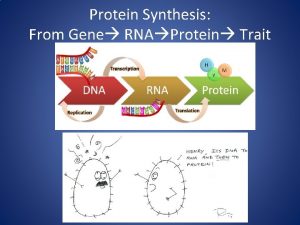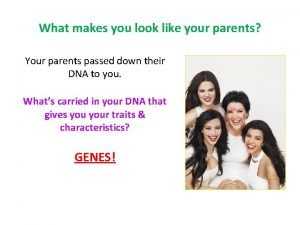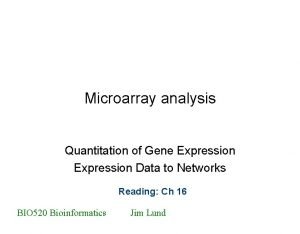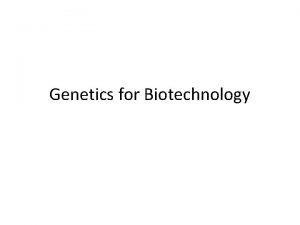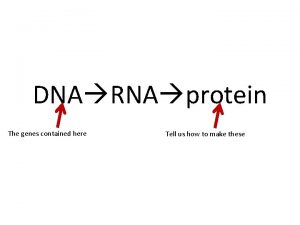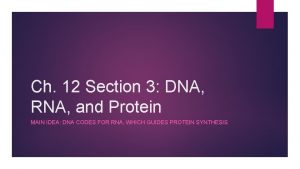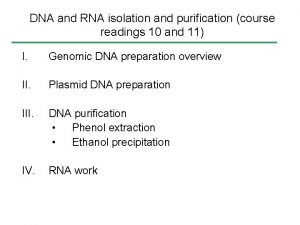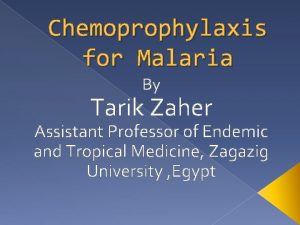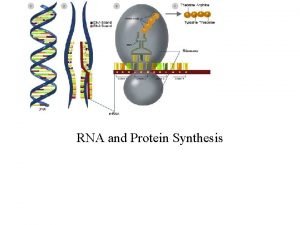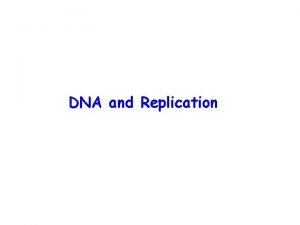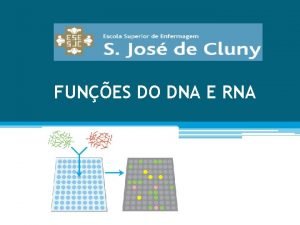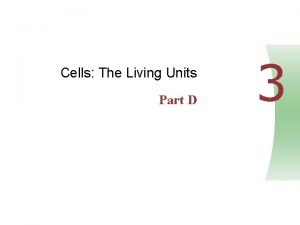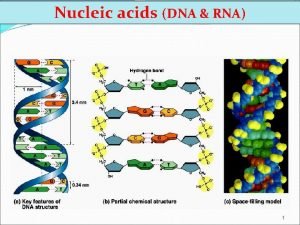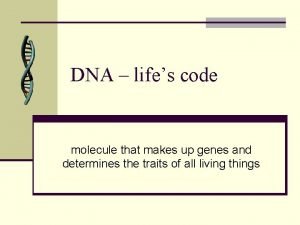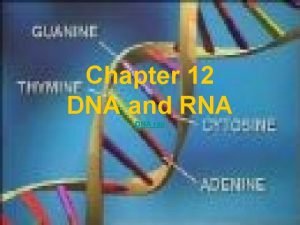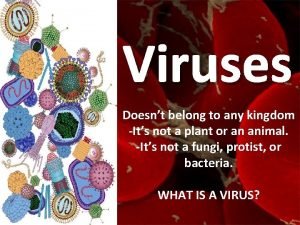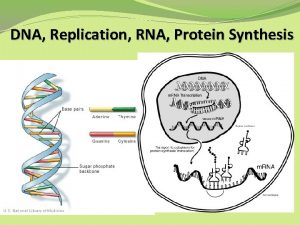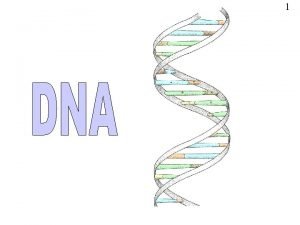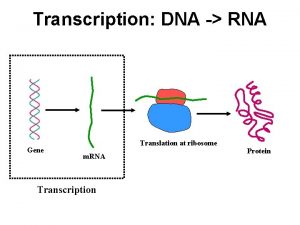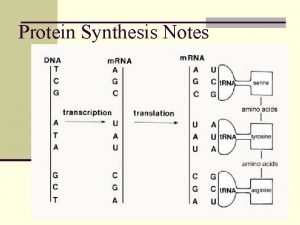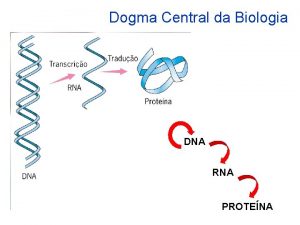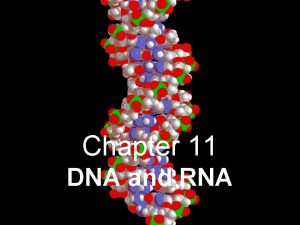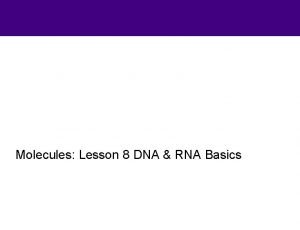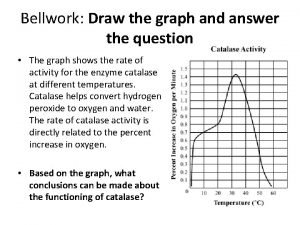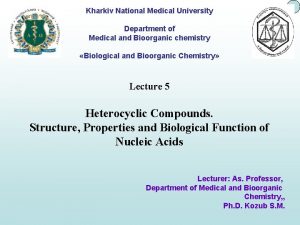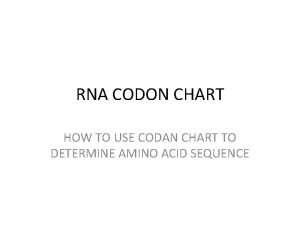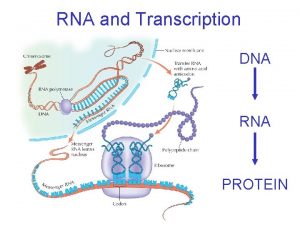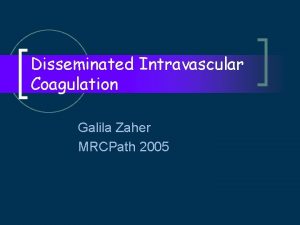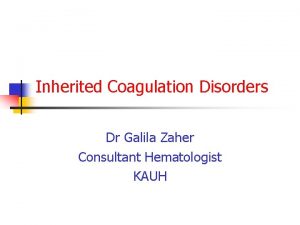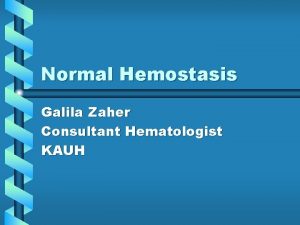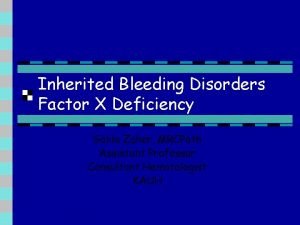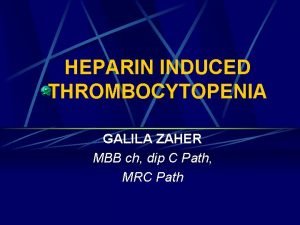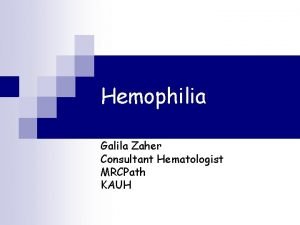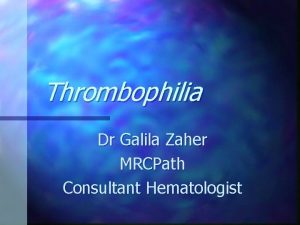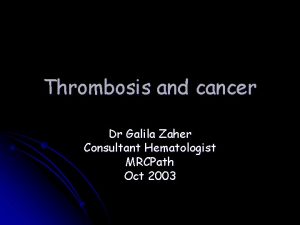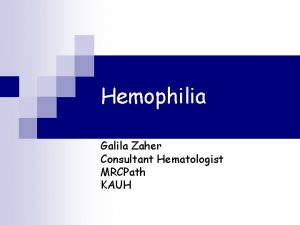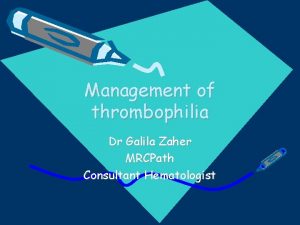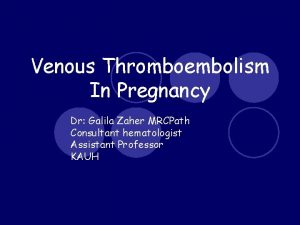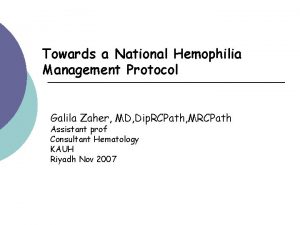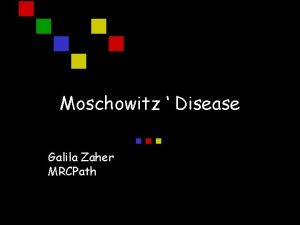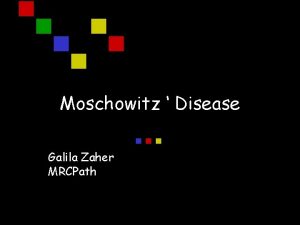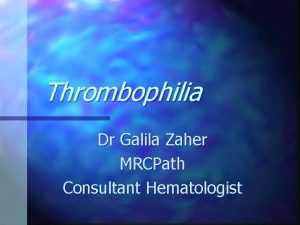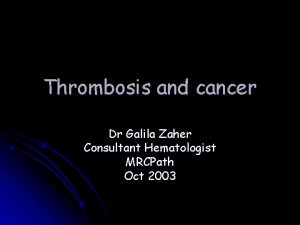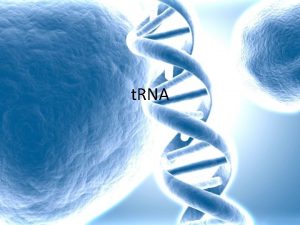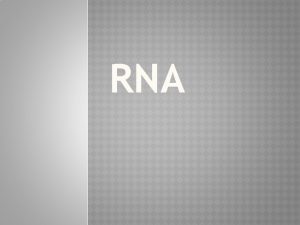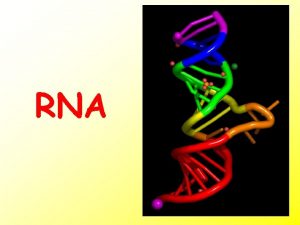Molecular Hematology Galila Zaher DNA RNA Protein DNA



![DNA: Building Blocks Bases Purines Pyrimidine Purine Pyrimidines Adenine Guanine Cytosine Thymine [Uracil] Purine DNA: Building Blocks Bases Purines Pyrimidine Purine Pyrimidines Adenine Guanine Cytosine Thymine [Uracil] Purine](https://slidetodoc.com/presentation_image/28d09823e4c97e7d6a71f5a07f46e006/image-4.jpg)




































- Slides: 40

Molecular Hematology Galila Zaher

DNA RNA Protein

DNA & RNA Double-stranded 4 bases: A, C, G & T Sugar: Deoxribose Stable molecule Introns + Exons RNA Single-stranded A, C, G & U Sugar: Ribose Unstable molecule Introns
![DNA Building Blocks Bases Purines Pyrimidine Purine Pyrimidines Adenine Guanine Cytosine Thymine Uracil Purine DNA: Building Blocks Bases Purines Pyrimidine Purine Pyrimidines Adenine Guanine Cytosine Thymine [Uracil] Purine](https://slidetodoc.com/presentation_image/28d09823e4c97e7d6a71f5a07f46e006/image-4.jpg)
DNA: Building Blocks Bases Purines Pyrimidine Purine Pyrimidines Adenine Guanine Cytosine Thymine [Uracil] Purine ‘pair’ pyrimidine Adenine-Thymine Guanine-Cytosine

DNA Nature paper here

Chromosomes Male karyotype 46: XY Female karyotype 46: XX 22 pairs of autosomes + 1 pair sex chromosomes

Normal Structure �Somatic cell has 46 chromosomes : diploid. �Ova and sperm have 23 chromosomes : haploid. �Karyotype shows chromosomes of dividing cell in numerical order.


Chromosome has two arms: Short arm = p Long arm = q.

Short and long arms meet at the Centromere.

Ends of the chromosomes are called Telomeres

Each arm is divided into regions numbered from centromere.

Each region is divided into bands.


Numerical Abnormality � Aneuploid: Somatic cell with >or <46 chromosomes A. Hyperdiploid: >46 chromosomes B. Hypodiploid : <46 chromosomes. � Pseudodiploid: 46 chromosomes but with rearrangements.

Structural Abnormality �del : deletion where part of chromosome is lost del(16 q). �Add: additional material has replaced part of a Ch �t: Translocation t(9; 22) �inv : inversion; part of Ch runs in opposite direction. �Point mutation �Non sense : Result in creation of premature stop codon Normal sequence ATG CTG TGC Cys Mutant sequence ATG CTG TGA stop �i: isochromosome is a chromosome with identical chromosome arms at each end, e. g. i(17 q) has two copies of 17 q joined at centromere.

Haematological Malignancies �Mostly clonal disorders resulting from a genetic alteration. �Tumor-Suppressor Genes : inhibit expression of tumor phenotype. When are inactivated or lost abnormal proliferation �Oncogenes : Genes which can potentially induce neoplastic transformation. They include genes for growth factors, growth factor receptors, protein kinases, etc.


Genetics of Haematological Malignancies Mutation Proto-oncogene Normal proliferation / Apoptosis Tumour-suppressor gene Oncogene Excess proliferation / loss of Apoptosis Mutation or deletion Tumour-suppressor gene

Clonal Progression �Activation of Oncogenes �Inactivation of Tumour-Suppressor Genes �Malignant cells acquire new characteristics causing acceleration. �Multidrug resistance (MDR) is one complication. Cells start to express a protein which actively pumps chemotherapeutic agent to outside of cells.

Thalassemia � Heterogenous group of genetic disorders Mutation decrease rate of synthesis of globin chains ( or ). � 0 : complete absence of chain. Common in Mediterranean. � + : partial block in chain synthesis. 1. Noncoding introns inefficient RNA splicing , decreased m. RNA production 2. Promoter leading to decreased expression 3. Termination site production of longer, unstable m. RNA Partial or total deletion of a globin gene � thalassemia major : 0/ 0, +/ +, or 0/ +

ß-Thalassemias � Disease manifests itself when switch chain ms after birth � Imbalanced synthesis low Hb production, MCV & MCH � Excess chains precipitate in RBC precursors in bone marrow leading to hemolysis and ineffective erythropoiesis � Excess chains in circulating RBCs precipitate leading to pitting in spleen & RBC survival via a chronic hemolytic process. � The major cause of severe anemia is the ineffective erythropoiesis. � Compensatory increase in & chain synthesis Hb F& A 2.

Hereditary thrombophilia �PC �PS �AT �Prothrombin Gene Mutation: G 20210 A. �Factor V Leiden Mutation: R 506 Q. �MTRFR : mutation

INHERITED RISK FACTORS Relative risk of VTE 50 - to 80 fold 80 70 60 50 40 30 20 10 -fold 10 - fold 5 - to 8 fold 2 -to 4 - fold 0 Heterozygous deficiency of AT, PC, PS Heterozygous G 1691 A FV Homozyougs G 1691 A FV Heterozygous G 20210 prothrombin Homozyg prothrombin

Gene Structure Splice sites

X-linked Disorders �Haemophilia A and B �X-linked disorders �Males affected – females carriers

Queen Victoria (1819 - 1901) Queen Victoria Queen of England from 1837 to 1901 was a carrier. Her eighth child, Leopold, had Hemophilia and suffered from frequent hemorrhage.

Royal Disease Descendants Eugenie, who was a carrier introduced Hemophilia into Spanish royal family. Irene married to Prince Henry of Prussia introduced the disease into the German royal family Alexandra married Russia's last czar Nicholas II introduced the disease into the Russia royal family, which ultimately played a role in the start of the Russian Revolution.

Alexis, son of Nicholas and Alexandra (1904 - 1918) Alexandra gave birth to a son Alexis the long awaited heir Russian throne. Unfortunately Alexis had Hemophilia which ultimately played a role in the start of the Russian Revolution.

Victoria will be remembered as the cause of Hemophilia which spread to the Royal Family of Europe through her descendants

F 8 Gene

FIX Gene

Types of Mutations �Missense mutations �Nonsense mutations �Splice mutations �Insertions �Deletions

Inversions Sever HA SHA: Intron 22: Intron 1: ~50% cases <1% cases

Haemophilia A: Intron 22 Inversion

Cytogenetic &Molecular studies • • • Karyotype Analysis (numerical ) Immunofluorescence Staining (structural) Fluorescent in situ Hybridisation (FISH) Southern Blot Analysis Polymerase Chain Reaction (PCR) t(9, 22), hemophilia, thrombophilia DNA Microarray Platforms

Chromosomes Male karyotype 46: XY Female karyotype 46: XX 22 pairs of autosomes + 1 pair sex chromosomes



 Chapter 11 dna and genes
Chapter 11 dna and genes Rna and protein synthesis study guide
Rna and protein synthesis study guide Protein
Protein Dna rna protein central dogma
Dna rna protein central dogma Microarray analysis
Microarray analysis Dna rna protein central dogma
Dna rna protein central dogma Dna rna protein
Dna rna protein Chapter 12 section 3 dna rna and protein
Chapter 12 section 3 dna rna and protein Dna rna protein diagram
Dna rna protein diagram Tarık zaher
Tarık zaher N
N Leishmaniasis
Leishmaniasis Chemoprophylaxis
Chemoprophylaxis Tarık zaher
Tarık zaher Messenger rna codons
Messenger rna codons Rna transfer
Rna transfer Section 12-3 rna and protein synthesis
Section 12-3 rna and protein synthesis Totipotent cells
Totipotent cells Protein-protein docking
Protein-protein docking Channel vs carrier proteins
Channel vs carrier proteins Minor groove
Minor groove Dna e rna
Dna e rna Dna to rna transcription
Dna to rna transcription Perbedaan replikasi virus dna dan rna
Perbedaan replikasi virus dna dan rna Phosphodiester bonds
Phosphodiester bonds What is the goal of replication
What is the goal of replication Why dna is more stable than rna?
Why dna is more stable than rna? Dna rna
Dna rna What kingdom do viruses belong to
What kingdom do viruses belong to Dna and rna
Dna and rna What is code 1
What is code 1 Dna to rna transcription
Dna to rna transcription Substansi genetik dna dan rna mempunyai kesamaan yaitu
Substansi genetik dna dan rna mempunyai kesamaan yaitu Unlike dna, rna contains
Unlike dna, rna contains Dogma central da biologia molecular mapa mental
Dogma central da biologia molecular mapa mental Dna nucleotide
Dna nucleotide Rna dna
Rna dna Dna and rna
Dna and rna Dna to rna rules
Dna to rna rules James dewey watson
James dewey watson Ucag chart
Ucag chart


